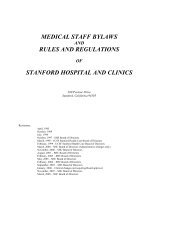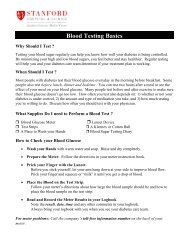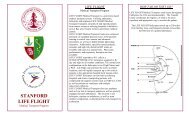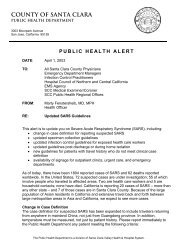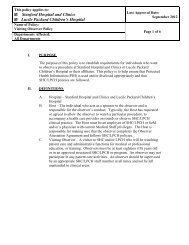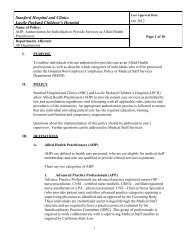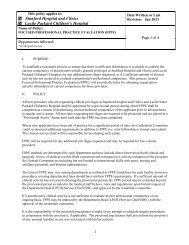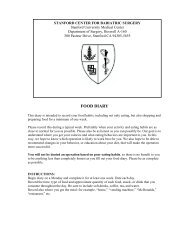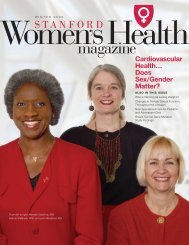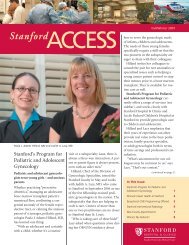rEdEFInIng - Stanford Hospital & Clinics
rEdEFInIng - Stanford Hospital & Clinics
rEdEFInIng - Stanford Hospital & Clinics
You also want an ePaper? Increase the reach of your titles
YUMPU automatically turns print PDFs into web optimized ePapers that Google loves.
NEURoLoGY<br />
A BETTER WAY To do IT<br />
Surgery of any kind near the brain stem carries precipitous risks of damage<br />
with catastrophic consequences. Traditionally, neurosurgeons have taken<br />
their instruments to that area only through the mouth or the side of the neck,<br />
although both approaches risk adverse effects on swallowing, breathing and<br />
speech, and require a long recovery. Surgeries that go through the nasal<br />
passages to the eye and the brain have been possible only in the last decade<br />
or so. New imaging technologies and new, extended surgical tools are more<br />
flexible, optically sharper and much, much smaller. At <strong>Stanford</strong> <strong>Hospital</strong>,<br />
endonasal surgery is thriving, with vibrant collaborations between the<br />
Neurosurgery and Otolaryngology Departments.<br />
8<br />
forging<br />
DR. STEFAN MINDEA HAS PIONEERED NEW<br />
TECHNIquES TO DECREASE RISk DuRINg<br />
BRAIN AND SPINAl SuRgERY WHIlE INCREASINg<br />
PATIENT COMFORT THROugHOuT RECOVERY.<br />
Return to TOC<br />
nEW<br />
pathsTO<br />
SuCCESS<br />
“This surgery meant going home sooner<br />
and with much less pain and fewer risks<br />
of complications.”<br />
Dr. Stefan Mindea<br />
Director of the Neurosurgery Department’s<br />
Minimally Invasive Spinal Surgery Program<br />
Sandi Wearing’s MRI showed a mass at the very top<br />
of her spinal column, providing one possible explanation<br />
for what was making her speech difficult and her arms<br />
weak. At <strong>Stanford</strong>, Sandi found two physician-scientists,<br />
Dr. Stefan Mindea and Dr. Jayakar Nayak, who would<br />
save her speech with an advanced surgical procedure that<br />
reached her spine through her nose and sinuses. Never<br />
before done at <strong>Stanford</strong>, the endonasal odontoidectomy<br />
is a rarely performed procedure. There are just a handful<br />
of medical centers anywhere that can accomplish this level<br />
of endonasal surgery.<br />
A chance meeting in the faculty lounge brought together<br />
Sandi’s surgeons—Dr. Mindea, Director of the Neurosurgery<br />
Department’s Minimally Invasive Spinal Surgery Program, and<br />
Dr. Nayak, Co-director of the Otolaryngology Department’s<br />
<strong>Stanford</strong> Sinus Center. Dr. Mindea was frustrated with the<br />
surgical routes typically used to reach the spine through the<br />
mouth or neck. Dr. Nayak, who regularly performs transnasal<br />
sinus and skullbase surgery, knew how to reach the spine<br />
through the nasal cavity. “For the right patient, you can<br />
get to a site of interest with much less pain and dissection<br />
through normal tissues,” says Dr. Nayak.<br />
With a new path identified, Dr. Mindea was confident he<br />
could cut down his patient’s recovery time and increase<br />
her comfort. “This surgery meant going home sooner and<br />
with much less pain and fewer risks of complications,”<br />
he says. The successful surgery safely removed the mass.<br />
Sandi has been speaking confidently and using her arms<br />
freely ever since.<br />
9




